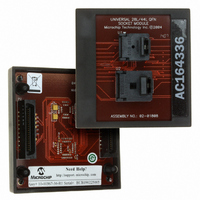AC164336 Microchip Technology, AC164336 Datasheet - Page 33

AC164336
Manufacturer Part Number
AC164336
Description
MODULE SOCKET FOR PM3 28/44QFN
Manufacturer
Microchip Technology
Datasheet
1.AC164335.pdf
(286 pages)
Specifications of AC164336
Module/board Type
Socket Module - QFN
Product
Microcontroller Accessories
Lead Free Status / RoHS Status
Not applicable / Not applicable
For Use With/related Products
MPLAB® PM3
Lead Free Status / RoHS Status
Lead free / RoHS Compliant, Not applicable / Not applicable
- Current page: 33 of 286
- Download datasheet (5Mb)
3.1.1
This architecture fetches 24-bit wide program memory.
Consequently, instructions are always aligned. How-
ever, as the architecture is modified Harvard, data can
also be present in program space.
There are two methods by which program space can
be accessed; via special table instructions, or through
the remapping of a 16K word program space page into
the upper half of data space (see Section 3.1.2 “Data
Access from Program Memory Using Program
Space Visibility”). The TBLRDL and TBLWTL instruc-
tions offer a direct method of reading or writing the least
significant word (lsw) of any address within program
space, without going through data space. The TBLRDH
and TBLWTH instructions are the only method whereby
the upper 8 bits of a program space word can be
accessed as data.
The PC is incremented by two for each successive
24-bit program word. This allows program memory
addresses to directly map to data space addresses.
Program memory can thus be regarded as two 16-bit
word wide address spaces, residing side by side, each
with the same address range. TBLRDL and TBLWTL
access the space which contains the Least Significant
Data Word, and TBLRDH and TBLWTH access the
space which contains the Most Significant Data Byte.
Figure 3-2 shows how the EA is created for table oper-
ations and data space accesses (PSV = 1). Here,
P<23:0> refers to a program space word, whereas
D<15:0> refers to a data space word.
FIGURE 3-3:
© 2006 Microchip Technology Inc.
Program Memory
‘Phantom’ Byte
(Read as ‘0’).
DATA ACCESS FROM PROGRAM
MEMORY USING TABLE
INSTRUCTIONS
PC Address
0x000004
0x000006
0x000002
0x000000
PROGRAM DATA TABLE ACCESS (LEAST SIGNIFICANT WORD)
00000000
00000000
00000000
00000000
23
TBLRDL.W
Preliminary
16
A set of Table Instructions is provided to move byte or
word sized data to and from program space.
1.
2.
3.
4.
dsPIC30F1010/202X
TBLRDL: Table Read Low
Word: Read the lsw of the program address;
P<15:0> maps to D<15:0>.
Byte: Read one of the LSBs of the program
address;
P<7:0> maps to the destination byte when byte
select = 0;
P<15:8> maps to the destination byte when byte
select = 1.
TBLWTL: Table Write Low (refer to Section 7.0
“Flash Program Memory” for details on Flash
Programming).
TBLRDH: Table Read High
Word: Read the most significant word of the
program address;
P<23:16> maps to D<7:0>; D<15:8> always
be = 0.
Byte: Read one of the MSBs of the program
address;
P<23:16> maps to the destination byte when
byte select = 0;
The destination byte will always be = 0 when
byte select = 1.
TBLWTH: Table Write High (refer to Section 7.0
“Flash Program Memory” for details on Flash
Programming).
TBLRDL.B (Wn<0> = 1)
8
TBLRDL.B (Wn<0> = 0)
0
DS70178C-page 31
Related parts for AC164336
Image
Part Number
Description
Manufacturer
Datasheet
Request
R

Part Number:
Description:
Manufacturer:
Microchip Technology Inc.
Datasheet:

Part Number:
Description:
Manufacturer:
Microchip Technology Inc.
Datasheet:

Part Number:
Description:
Manufacturer:
Microchip Technology Inc.
Datasheet:

Part Number:
Description:
Manufacturer:
Microchip Technology Inc.
Datasheet:

Part Number:
Description:
Manufacturer:
Microchip Technology Inc.
Datasheet:

Part Number:
Description:
Manufacturer:
Microchip Technology Inc.
Datasheet:

Part Number:
Description:
Manufacturer:
Microchip Technology Inc.
Datasheet:

Part Number:
Description:
Manufacturer:
Microchip Technology Inc.
Datasheet:










